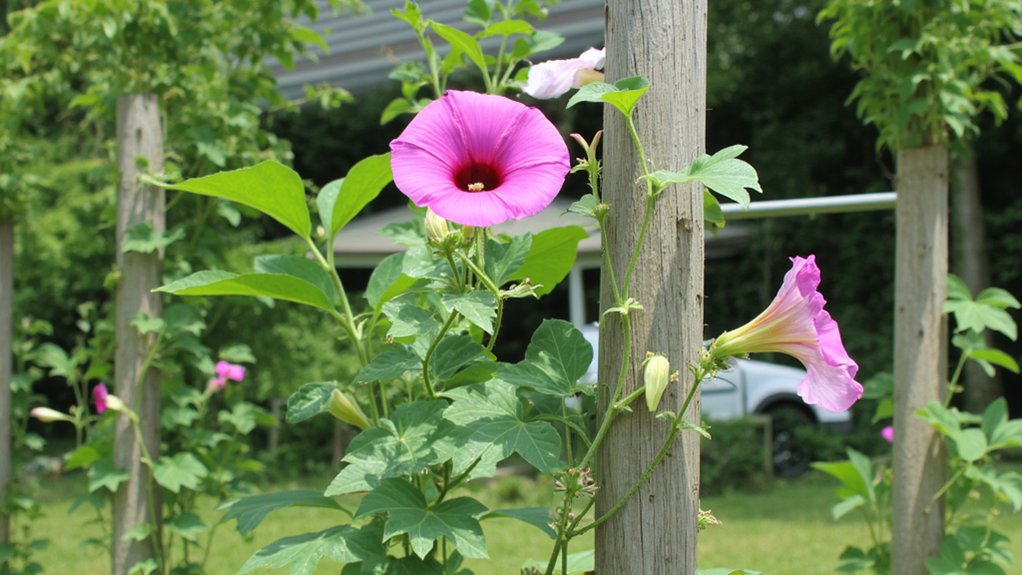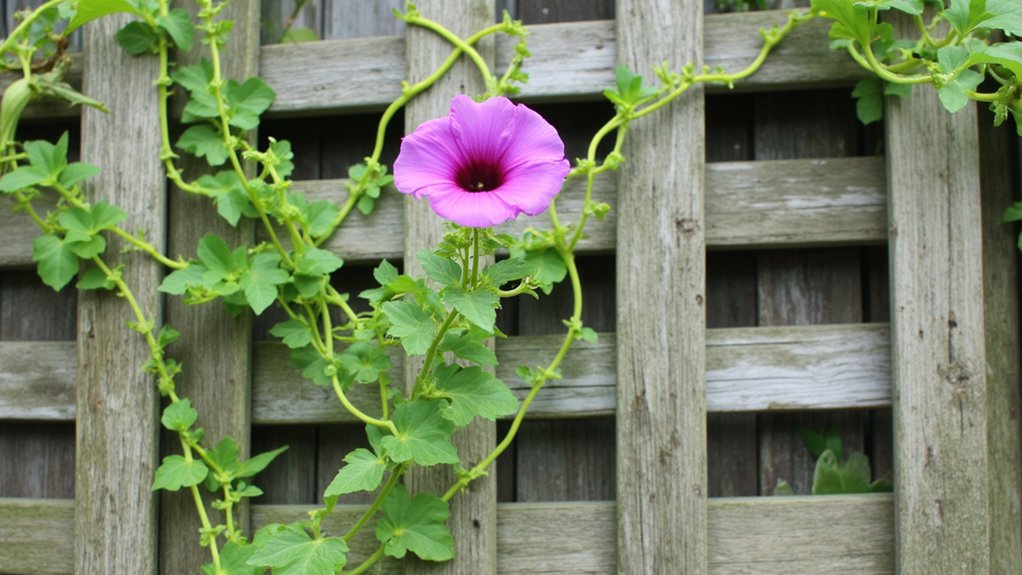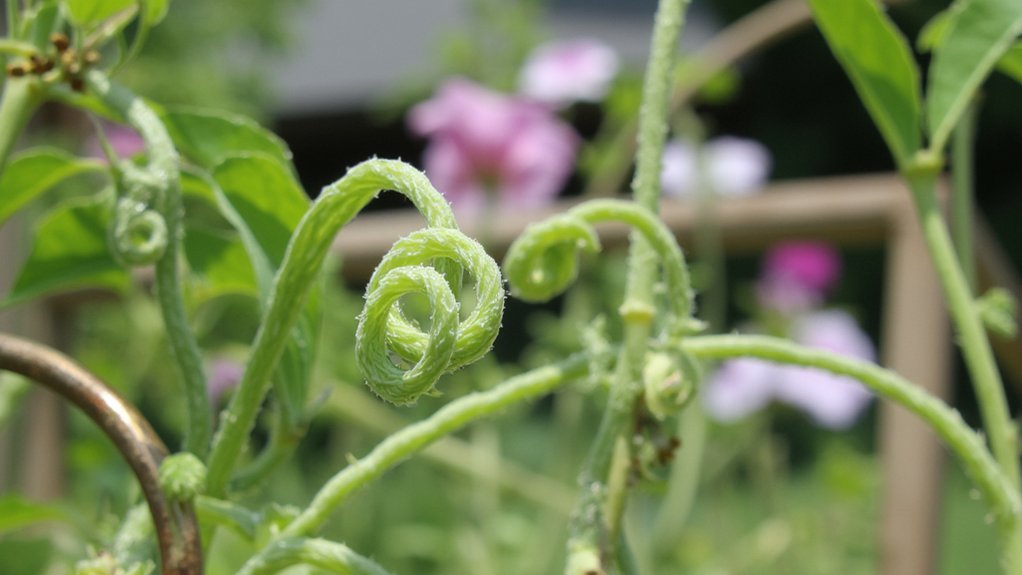You’ve probably watched a vine climb up a wall or trellis, but you might not realize the sophisticated biology happening before your eyes. These green acrobats complete a full spiral rotation every 1-3 hours as they search for support, using a combination of touch-sensitive growth and hormonal responses. It’s more than random wandering – vines employ precise cellular mechanisms that would impress any engineer, and their methods might surprise you.
Contents
The Natural Engineering of Vine Movement

While many plants grow straight upward, vines have developed an extraordinary method of movement called circumnutation. You’ll notice that vines don’t just randomly twist – they’re following a precise spiral pattern that helps them find support structures.
When you look closely at a vine’s growing tip, you’ll see it moving in a circular motion, completing one full rotation every 1-3 hours. This movement’s driven by specialized cells that expand and contract rhythmically, creating an internal motor that propels the vine forward.
You can actually track a vine’s movement by marking its tip with a small dot and photographing it over time.
Understanding Thigmotropism in Climbing Plants

As climbing plants encounter physical objects, they exhibit a remarkable growth response called thigmotropism – the ability to sense and grow toward touch stimuli. You’ll notice this behavior when a vine’s stem makes contact with a support structure, triggering a cascade of hormonal changes within minutes.
The plant’s cells on the touched side begin to grow more slowly than those on the opposite side. This differential growth rate causes the stem to curve around the support. You can observe this process happening in real-time, as some vines complete a full coil within 4-8 hours of initial contact.
The strength of the response varies among species, with morning glories and pole beans showing particularly vigorous thigmotropic reactions.
Cellular Mechanics Behind Spiral Growth

Once a climbing plant initiates its twisting motion, complex changes occur at the cellular level to create that signature spiral growth pattern. You’ll find specialized cells along the vine’s outer surface stretching and expanding at different rates, while inner cells contract.
The process relies on auxin, a growth hormone that triggers cell elongation. When you look closely, you’ll notice that cells on one side of the vine grow up to 20% longer than those on the opposite side, creating an asymmetrical growth pattern.
This uneven cellular expansion creates internal tension that forces the vine to coil, typically completing one full spiral every 24-48 hours.
Environmental Triggers and Plant Responses
Before a climbing vine begins its spiral journey, specific environmental factors must trigger its growth response. You’ll notice that light intensity, gravity, and physical contact all play essential roles in determining how your vine will twist and climb.
When light hits a vine’s stem, you can observe phototropism in action as it bends toward the brightness within 2-6 hours. Touch sensors along the stem respond to contact within minutes, triggering rapid cell growth that causes the vine to curl around supports.
Gravity’s influence, called gravitropism, helps vines distinguish up from down, ensuring they grow skyward even in low-light conditions.
While environmental triggers start the climbing process, plant hormones orchestrate the intricate dance of vine movement. You’ll find that auxin, the primary growth hormone, accumulates on the shaded side of the vine’s stem, causing those cells to elongate faster than cells in direct light.
When you examine climbing vines closely, you’ll notice that ethylene, another key hormone, enhances the plant’s sensitivity to touch. Working together with auxin, it helps create the spiral growth pattern you’re seeing. The vine’s stem cells respond within minutes, bending and twisting to secure an effective grip on nearby supports.
Evolution of Climbing Mechanisms
As plants adapted to compete for sunlight millions of years ago, climbing mechanisms emerged independently across multiple species. You’ll find that vines developed four main strategies: twining stems, leaf tendrils, adhesive pads, and root climbers.
The earliest fossil evidence of climbing plants dates back 90 million years, showing that twining stems likely evolved first. You can see this primitive mechanism in modern morning glories, which use their entire stem to wrap around supports.
Over time, specialized structures like tendrils appeared, letting plants climb more efficiently with less biomass investment. Today’s passion flowers demonstrate this advanced adaptation, using modified leaf tips to grip supports.
Future Applications in Bio-inspired Design
Scientists studying vine mechanics have sparked numerous innovations in robotics and architecture. You’ll find these bio-inspired designs in climbing robots that can scale walls and wrap around poles, mimicking a vine’s natural movements.
The applications don’t stop there. Engineers have developed self-tightening sutures based on how vines coil, and they’re working on flexible building materials that can adapt to environmental stresses. You’re likely to see these concepts in future disaster-resistant structures.
In medical devices, vine-inspired designs are revolutionizing minimally invasive surgery. Imagine flexible probes that can navigate your body’s pathways with the same precision as a climbing tendril.
